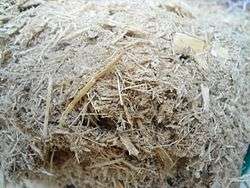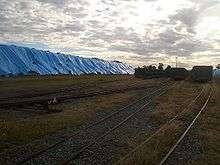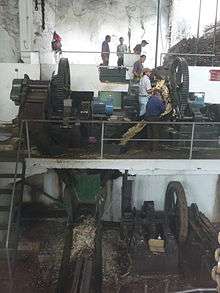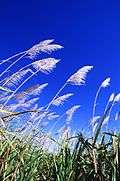Bagasse

Bagasse (/bəˈɡæs/ bə-GAS) is the fibrous matter that remains after sugarcane or sorghum stalks are crushed to extract their juice. It is dry pulpy residue left after the extraction of juice from sugar cane.[1] Bagasse is used as a biofuel and in the manufacture of pulp and building materials.
Agave bagasse is a similar material that consists of the tissue of the blue agave after extraction of the sap.
Bagasse can also be very useful to generate electricity. Dry bagasse is burnt to produce steam. The steam is used to rotate turbines to produce power.
Production, storage and composition
For every 10 tonnes of sugarcane crushed, a sugar factory produces nearly three tonnes of wet bagasse. Since bagasse is a by-product of the cane sugar industry, the quantity of production in each country is in line with the quantity of sugarcane produced.
The high moisture content of bagasse, typically 40–50 percent, is detrimental to its use as a fuel. In general, bagasse is stored prior to further processing. For electricity production, it is stored under moist conditions, and the mild exothermic process that results from the degradation of residual sugars dries the bagasse pile slightly. For paper and pulp production, it is normally stored wet in order to assist in removal of the short pith fibres, which impede the paper making process, as well as to remove any remaining sugar.
A typical chemical analysis of washed and dried bagasse might show:[2]
- Cellulose 45–55 percent
- Hemicellulose 20–25 percent
- Lignin 18–24 percent
- Ash 1–4 percent
- Waxes <1 percent
Bagasse is a heterogeneous material containing around 30-40 percent of "pith" fibre, which is derived from the core of the plant and is mainly parenchyma material, and "bast", "rind", or "stem" fibre, which makes up the balance and is largely derived from sclerenchyma material. These properties make bagasse particularly problematic for paper manufacture and have been the subject of a large body of literature.
Uses

Many research efforts have explored using bagasse as a renewable power generation source and for the production of bio-based materials.
Fuel
Bagasse is often used as a primary fuel source for sugar mills. When burned in quantity, it produces sufficient heat energy to supply all the needs of a typical sugar mill, with energy to spare. To this end, a secondary use for this waste product is in cogeneration, the use of a fuel source to provide both heat energy, used in the mill, and electricity, which is typically sold on to the consumer electrical grid.
The lower calorific value (LCV) of bagasse in kJ/kg may be estimated using the formula: LCV = 18260 - 207.01 × Moisture - 31.14 × Brix - 182.60 × Ash, where the moisture, brix and ash content of the bagasse are expressed as a percentage by mass. Similarly, the higher calorific value (HCV) of bagasse may be estimated using: HCV = 19605 - 196.05 × Moisture - 31.14 × Brix - 196.05 × Ash.[3]
The resulting CO2 emissions are less than the amount of CO2 that the sugarcane plant absorbed from the atmosphere during its growing phase, which makes the process of cogeneration greenhouse gas neutral. In countries such as Australia, sugar factories contribute "green" power to the electricity grid. Florida Crystals Corporation, one of America's largest sugar companies, owns and operates the largest biomass power plant in North America. The 140 MW facility uses bagasse and urban wood waste as fuel to generate enough energy to power its milling and refining operations as well as supply enough renewable electricity for nearly 60,000 homes. Hawaiian Electric Industries also burns bagasse for cogeneration.
Ethanol produced from the sugar in sugarcane is a popular fuel in Brazil. The cellulose-rich bagasse is being widely investigated for its potential for producing commercial quantities of cellulosic ethanol. For example, until May 2015 BP was operating a cellulosic ethanol demonstration plant based on cellulosic materials in Jennings, Louisiana.
Bagasse's potential for advanced biofuels has been shown by several researchers.[4][5] However, the compatibility with conventional fuels and suitability of these crude fuels in conventional engines have yet to be proven.[6]
Pulp, paper, board and feed
Bagasse is commonly used as a substitute for wood in many tropical and subtropical countries for the production of pulp, paper and board, such as India, China, Colombia, Iran, Thailand, and Argentina. It produces pulp with physical properties that are well suited for generic printing and writing papers as well as tissue products but it is also widely used for boxes and newspaper production.[2] It can also be used for making boards resembling plywood or particle board, called Bagasse board and Xanita board, and is considered a good substitute for plywood. It has wide usage for making partitions and furniture.
The industrial process to convert bagasse into paper was developed in 1937 in a small laboratory in Hacienda Paramonga, a sugar mill in the coast of Peru owned by W.R. Grace Company. With a promising method, the company bought an old paper mill in Whippany, New Jersey and shipped bagasse from Peru to test the viability of the process on an industrial scale. The first paper manufacturing machine were designed in Germany and installed in the Cartavio sugar cane plant in 1938.[7] Sociedad Paramonga was bought in 1997 by Quimpac[8] and in 2015 produced 90,000 metric tons of office paper, toilet paper and cardboard for the Peruvian market.[9]
K-Much Industry has patented a method of converting bagasse into cattle feed by mixing it with molasses and enzymes (such as bromelain) and fermenting it. It is marketed in Thailand, Japan, Malaysia, Korea, Taiwan and Middle East and Australia as "fiber rich".
Xanita, a South African company, mixes 30 percent bagasse cellulose fibres in with recycled kraft paper fibre to make ultra lightweight composite boards. These are sold as an environmentally-friendly, formaldehyde-free alternative to MDF and particle board.[10]
Tableware and dinnerware
Being socially responsible some caterers and cafeteria in the world have started using dinnerware made from bagasse.
Health impact
Workplace exposure to dust from the processing of bagasse can cause the chronic lung condition pulmonary fibrosis, more specifically referred to as bagassosis.[11]
Human consumption
Processed bagasse is added to human food as sugar cane fiber.[12] It is a soluble fiber but can help promote intestinal regularity.[12] One animal study suggests that sugar cane fiber combined with a high fat diet may help control type 2 diabetes.[13] Bagasse are good sources of lignoceric and cerotic acids.[14]
In Guangxi Zhuang Autonomous Region, China, bagasse is sometimes used to smoke bacon and sausages.
See also
| Wikimedia Commons has media related to Bagasse. |
References
- ↑ "bagasse - fibre".
- 1 2 Rainey, Thomas J (2009). A study of the permeability and compressibility properties of bagasse pulp. Brisbane: Queensland University of Technology.
- ↑ Wienese, Arnoud (2001). "Boilers, boiler fuel and boiler efficiency" (PDF). Proceedings of the South African Sugar Technologists' Association. 75: 275–281.
- ↑ Kosinkova, Jana; Ramirez, Jerome; Jablonsky, Michal; Ristovski, Zoran; Brown, Richard; Rainey, Thomas (24 May 2017). "Energy and chemical conversion of five Australian lignocellulosic feedstocks into bio-crude through liquefaction". RSC Advances. 7 (44): 27707–27717. doi:10.1039/C7RA02335A.
- ↑ Chumpoo, Jade; Prasassarakich, Pattarapan (24 February 2010). "Bio-Oil from Hydro-Liquefaction of Bagasse in Supercritical Ethanol". Energy&Fuels. 24 (3): 2071–2077. doi:10.1021/ef901241e.
- ↑ Ramirez, Jerome; Brown, Richard; Rainey, Thomas (1 July 2015). "A Review of Hydrothermal Liquefaction Bio-Crude Properties and Prospects for Upgrading to Transportation Fuels". Energies. 8 (7): 6765. doi:10.3390/en8076765.
- ↑ Lawrence A., Clayton (1985). Grace: W.R. Grace & Co., the Formative Years, 1850-1930. Ottawa, IL: Jameson Books. p. 354. ISBN 0915463253.
- ↑ "Quimpac corporate website". Quimpac – Nuestra empresa: Quienes Somos. Quimpac. Retrieved April 9, 2016.
- ↑ "Quimpac paper division". Quimpac – Negocios Papel. Quimpac. Retrieved April 9, 2016.
- ↑ "Home".
- ↑ Sodeman, William A (October 1967). "Bagasse Disease of the Lungs – After 25 Years" (PDF). Chest. 52 (4): 505–507. doi:10.1378/chest.52.4.505. PMID 6058449.
- 1 2 http://www.nutrition411.com/content/fiber-facts-understanding-food-labels-and-isolated-fibers
- ↑ Wang ZQ, Zuberi AR, Zhang XH, Macgowan J, Qin J, Ye X, Son L, Wu Q, Lian K, Cefalu WT (2007). "Effects of dietary fibers on weight gain, carbohydrate metabolism, and gastric ghrelin gene expression in mice fed a high-fat diet". Metab. Clin. Exp. 56: 1635–42. doi:10.1016/j.metabol.2007.07.004. PMC 2730183. PMID 17998014.
- ↑ Nnabugwu Agomuo E, Amadi Peter U (2018). "Nutrient and Antioxidant Properties of Oils from Bagasses, Agricultural Residues, Medicinal Plants, and Fodders". J Am Coll Nutr.: 1–9. doi:10.1080/07315724.2018.1484307. PMID 30052146.
Further reading
- The Potential of Bagasse-Based Cogeneration in the US, Kevin Ho, Columbia University, 2006.


